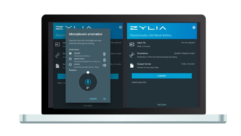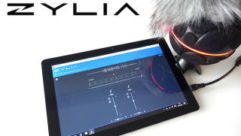Mems The Word
If you bought a phone in the past year, chances are good that its mic uses Micro-Electro-Mechanical Systems (MEMS) technology. And if you’ve installed a projector or rear-projection display anytime in the past several years, chances are even better that it used MEMS technology, particularly Texas Instruments’ Digital Light Processing (DLP) system.
If you bought a phone in the past year, chances are good that its mic uses Micro-Electro-Mechanical Systems (MEMS) technology. And if you’ve installed a projector or rear-projection display anytime in the past several years, chances are even better that it used MEMS technology, particularly Texas Instruments’ Digital Light Processing (DLP) system.
But how quickly MEMS makes its way into more pro products, including mics, remains to be seen. The wild card is a classic one: Many vendors and their investors prefer to focus on the consumer market, simply because it’s bigger and has more growth potential.
Akustica is among the companies offering microphones using Micro-Electro-Mechanical Systems (MEMS) technology.
Case in point: The number of MEMS mics shipped worldwide increased 90 percent between 2005 and 2006, with the total market worth $117 million, according to Yole Développement, a research firm based in France. Between 2006 and 2011, Yole forecasts a compound annual growth rate of 43 percent, with most of the boom coming from wider use of MEMS mics in cell phones.
As a result, companies that make MEMS components and mics see most sales continuing to come from the consumer market because that’s what their customers are focused on.
“In addition to being a much higher volume market, our customers have a compelling need for our digital MEMS microphones in mobile phones, laptop PCs, and other consumer electronics devices,” says Marcie Weinstein, director of strategic marketing at Pittsburgh-based Akustica. “Until the need and the market volume of another market like pro audio can measure up, it is unlikely that Akustica will develop microphones specifically [designed to meet the requirements] for those markets.”
Think Small
MEMS technology isn’t new. In fact, work on one of the best-known commercial MEMS AV products – TI’s DLP system – began in 1977, although it wasn’t commercialized until the 1990s. One common denominator across the years and products is the use of silicon as the foundation for tiny sensors, actuators, and electronics, although not all MEMS devices use silicon.
“Tiny” isn’t exaggerating. Some MEMS motors, powered by electricity, are about the diameter of a human hair. That scale is one of the reasons why, for example, a 1024 x 768 DLP projector can be physically compact yet house 2,359,296 micromirrors.
MEMS’ size makes the technology ideal for mics in cell phones, which are getting smaller and thinner because of consumer preference. That trend creates a need for components that don’t require much space. “Initial handset adoption was based primarily on the small size and surface mount capability of MEMS microphones, which provided new manufacturing efficiencies and the ability to design super-slim handsets,” Weinstein says.
MEMS also could be a good fit for some pro audio applications. One possibility is a mic so small that it can be hidden in an actor’s clothing or even affixed to the face. That flexibility could make MEMS attractive to rental/staging companies, system integrators, and users.
In early 2006, Akustica announced a Complementary Metal Oxide Semiconductor (CMOS) MEMS mic that features a silicon membrane and digital output, all on a single chip. This design is noteworthy for a couple of reasons. First, Akustica says that its MEMS mics can use standard CMOS wafers and manufacturing processes, reducing overhead costs because they don’t need custom materials and equipment. Second, Akustica’s ability to integrate the transducer and circuit on a single chip enables even smaller mics.
“Our CMOS MEMS is scalable to smaller sizes, higher production volumes, and additional features and functionality,” Weinstein says. “The small sizes, combined with the added benefits of on-chip signal processing, could be of great benefit [to pro applications].”
Tiny Technologies, Big Markets
Today, a variety of products outside of AV use MEMS, including automotive airbags, inkjet printers, hearing aids, and implantable medical sensors. Those applications are noteworthy because all that activity continues to drive innovation, some of which the AV industry potentially could leverage.
But for now, most vendors are focused on the consumer market, mainly because it’s bigger.
“At this time the pro audio market is not a main target for our MEMS mic,” says Teresa Bosch, marketing communications manager at Knowles Acoustics, based in Itasca, Ill. “The current MEMS product was designed and optimized for high-volume (millions per month) consumer electronics. We need the volumes in order to take advantage of semiconductor-type processes. There may be some future opportunities and merits for our MEMS mic in pro audio, but the current design is not optimized for these applications.”
That doesn’t necessarily mean MEMS mics won’t become common in pro AV. One reason is because consumer audio and video products increasingly are showing up in commercial applications, often because clients are looking to save money. That’s one way that MEMS mics could make their way into the pro space. Another is that some vendors believe that their consumer designs could be turned into pro products. For example, Akustica recently entered a cross-licensing agreement with Knowles Acoustics.
Good Enough for Pro?
Market factors aside, MEMS mics are practical for pro applications. Even so, there’s a perception that they don’t have the frequency response and sound pressure level handling capability necessary for applications such as live theater. But that perception is based partly on what most current MEMS mics are intended for, consumer-grade voice applications.
“Today, we are fundamentally focused on designing microphones that are optimized for the [PC, mobile phone, and] consumer electronics market,” Weinstein says. “We have tweaked the design to optimize performance for the voice band. However, the actual capabilities of the MEMS digital microphones extend out way beyond the voice band.”
FOR MORE INFORMATION
For more information about MEMS, check out:
www.allaboutmems.com and www.memsnet.org, which include technology primers, histories, and links to more information and vendors. The page at www.memsnet.org/mems/processes provides a good overview of how MEMS devices are fabricated.
Knowles Acoustics’ Web site: www.knowlesacoustics.com.
Akustica’s Web site: www.akustica.com.
“Fascinating Facts About DLP,” ProAV, April 2007, page 20.
EE Times‘ Q&A with TI’s Larry Hornbeck, inventor of the underlying technology in the its DLP system: www.eetimes.com/showArticle.jhtml?articleID=196902930.
MEMS mics are in the same boat as voice over IP (VoIP) telephony. Although most users have experience only with best-effort VoIP phones that sound nowhere near as good as old-fashioned circuit-switched telephony, VoIP is free to use voice-coding technologies that are superior to what circuit-switched phones can support. So like VoIP, MEMS’ ability to deliver an outstanding user experience depends largely on what it’s designed to deliver.
“There is no fundamental reason why MEMS microphones cannot deliver the desired frequency response shape out to 15 kHz or 20 kHz,” Weinstein says. “Many singers and drummers prefer a microphone without a flat frequency response for the way that it colors the sound. [MEMS mics also can] achieve the maximum sound pressure level values that are desired for pro audio applications.” In fact, cell phones highlight the ability of MEMS mics to step up when necessary. Although wireless calls often have audio quality that makes “Over” and “Roger, that,” seem necessary, service providers and handset vendors are working to change that in order to help convince more people to replace their wired phones altogether. As a result, mic quality has to improve, creating opportunities for MEMS manufacturers to show that their products can meet the new requirements.
To meet the growing demand for higher voice quality, “many handset makers will have to adopt better microphones, such as MEMS digital microphones, as well as microphone array technology,” Weinstein says. “MEMS microphones are inherently better matched in frequency and phase response than the traditional electret condenser mic. Therefore, as handset makers adopt multiple microphones along with noise suppression and beam forming algorithms to achieve the high-quality voice input that is required, MEMS microphones are a logical choice.”
Making MEMS mics for the pro market doesn’t necessarily mean overcoming big technological challenges.
“Fundamentally, there are no huge hurdles,” Weinstein says. “It just comes down to focusing on different performance specifications.”
Tim Kridel is a Columbia, Mo.–based freelance writer and analyst who covers telecom and technology. He can be reached at [email protected].










